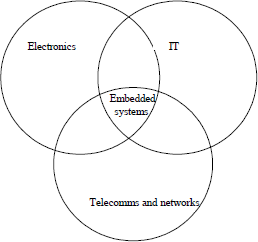Chapter 1
Introduction to Embedded Systems 1
1.1. Introduction
What do a mobile phone, a DVD player, a games console, an ADSL modem, a microwave oven, a car, and a rocket have in common? Our immediate response would be that:
– they are all autonomous electronic devices;
– they contain software designed specifically for a well defined task;
– they communicate with the outside world;
– they operate within an environment which is often outside their control.
All these characteristics are general characteristics of electronic devices that are known as embedded systems (ES). In recent years we have seen a sudden rise in interest in the design techniques involved in embedded systems.
Of course, the subject is hardly new or revolutionary, as we could say that these systems have been around for at least 40 years (for example, the guidance system in the Apollo lunar mission in the 1960s).
What is new is more the fact that today we can observe a convergence of different disciplines which often tend to be overlooked:
– electronics,
– IT,
– telecommunications and networks.
Today, embedded systems are at the heart of this convergence and we will be able to convince ourselves of this throughout this book. Figure 1.1 illustrates this convergence.
Figure 1.1. The convergence of electronics, IT, and telecommunications and networks

This convergence also determines the interdisciplinary nature of ...
Get Communicating Embedded Systems: Networks Applications now with the O’Reilly learning platform.
O’Reilly members experience books, live events, courses curated by job role, and more from O’Reilly and nearly 200 top publishers.

